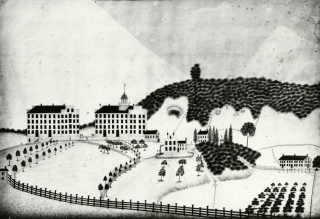and a scroll bearing the motto “Deo ac Veritati,” which also became permanent, though various renderings of it have subsequently been made.
From 1833 to 1846 the collegiate department graduated 251, and the theological department, 192 students. Of the latter, all but 20, represented men who had completed their undergraduate work at the Institution. Like the alumni of the pre-1833 period, most of them entered the ministry, where many achieved positions of eminence and distinction both in the churches of the United States and in the missionary field. Outstanding were William W. Everts, Class of 1837, prominent pastor in New York City and Chicago, and James N. Granger, Class of 1835 who filled the pulpit of the First Baptist Church of Providence, Rhode Island. Miles Bronson, Class of 1836, was a well-known missionary and teacher in Assam, and Edmund B. Cross, Class of 1839, worked among the Sgau Karens of Burma. Those who had noteworthy careers in non-preaching fields included William Carey Crane, Class of 1836, who became President of Baylor University; Orrin B. Judd, Class of 1841, editor of religious periodicals; and Andrew Ten Brook, Class of 1839, professor of philosophy at the University of Michigan and United States Counsul at Munich. Many others, also, brought credit to their Alma Mater who took pride in the accomplishments of her sons, and after 1846, often awarded them honorary degrees.





